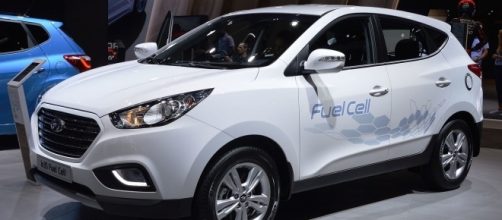Hyundai announced today it will unveil its next generation of hydrogen-fueled cars at the Winter Olympics in South Korea’s Alpine City in February 2018.
With a gaggle of reporters expected to be there,Hyundai hopes to capitalize on the free publicity and show off its second-generation hydrogen car.
Hyundai was the first automaker to mass produce a hydrogen-fueled car and promises their second generation vehicles will have even more features.
The car company is not alone. Tokyo, which is the host of the 2020 Olympics, will also be showcasing the power of hydrogen by creating an all-hydrogen powered village.
Hyundai to Release New Hydrogen-Powered Car in 2018 https://t.co/8aBctzfh5b #Hyundai #Ecofriendly #Hydrogen pic.twitter.com/dxcPnsqdbM
— Korea_Insight (@ZoomInKorea) July 29, 2016
A car that runs on water.
Hydrogen is not a plentiful gas like methane, but it’s locked inside every drop of water on the planet. With an estimated 249 miles (400 kilometers) on a single charge, the hydrogen-powered car handily beats electric vehicles (EVs) for distance and power.
Moreover, hydrogen emits only water vapor and oxygen upon combustion and are much easier on the environment. The traditional way to extract hydrogen is electrolysis, which breaks apart the hydrogen-oxygen bonds in water.
That process, however, requires a lot of energy, so unless the power needed is being generated by geothermal, nuclear, or hydrological power, the cost-benefits start to dwindle.
Wind and solar simply can’t generate the amount of energy needed to break the hydrogen-oxygen bonds. There’s also the secondary process of cooling and pressurizing hydrogen gas so it can be used in fuel cells. Once completed, cars built to use hydrogen are ready to roll.
Meager sales but zero emissions.
Hyundai says it has already sold about 500 hydrogen-powered vehicles and shipped 26 to Norway. South Korea and Tokyo have been developing hydrogen fuel cells as they don’t emit any greenhouse gases, which many believe contribute to global warming.
And unlike the U.S., neither country has natural resources like oil and gas.
Because of a lack of refueling stations, hydrogen cars are still a niche industry.
As noted, when the hydrogen combusts, it turns a rotor which generates electricity which powers the vehicle.
It emits zero carbon dioxide (CO2) emissions. Japan is also exploring an all-hydrogen society to combat CO2 emissions and has created the first city to run entirely on the gas.
2020 Tokyo Olympics.
Hydrogen will be on full display for the 2020 Olympic games in Tokyo. The training facilities, or Olympic Village, will run entirely on hydrogen power.
The governor of the Tokyo Metropolitan Government, Yoichi Masuzoe, has already allotted $350 million to subsidize hydrogen fuel cell cars and fueling stations ahead of the Olympics.
#ClimateAction!🌎
— Healing Inspirations (@RisingSign) June 9, 2016
Tokyo's Olympic Bet on Hydrogen Power - City Labhttps://t.co/1nIyO8tUTo pic.twitter.com/uDziqDlKXN
Fueling stations needed.
The final hurdle is finding a way to refuel your hydrogen-powered car.
Estimates for building a hydrogen fueling station are roughly five times higher than a traditional gasoline station.
Adding a fuel cell filling station is substantially lower, but requires the willingness of station owners to make the initial investment.
After adding electric charging stations to well-traveled areas in many cities for e-vehicles, station owners are regretting that venture as people simply aren’t using them.
As with any new technology, less market share equates to a more expensive product. But as hydrogen fuel extraction improves and car costs come down, there may be a sea change in how we view all our transportation needs and how they’re powered.

